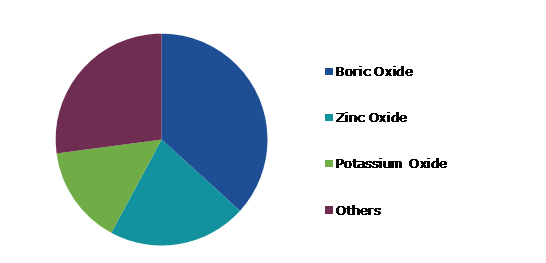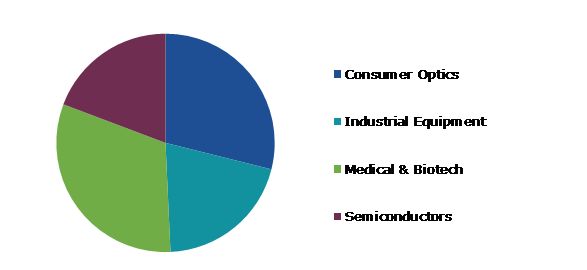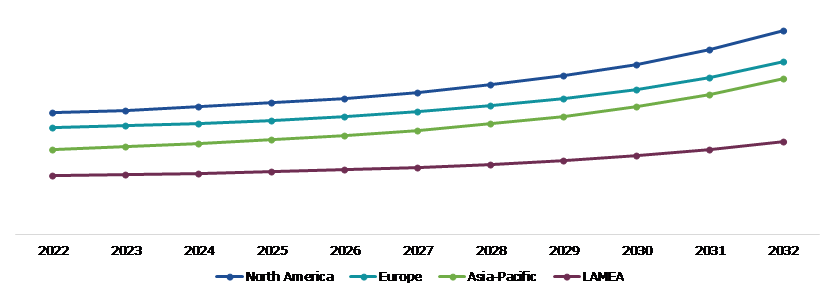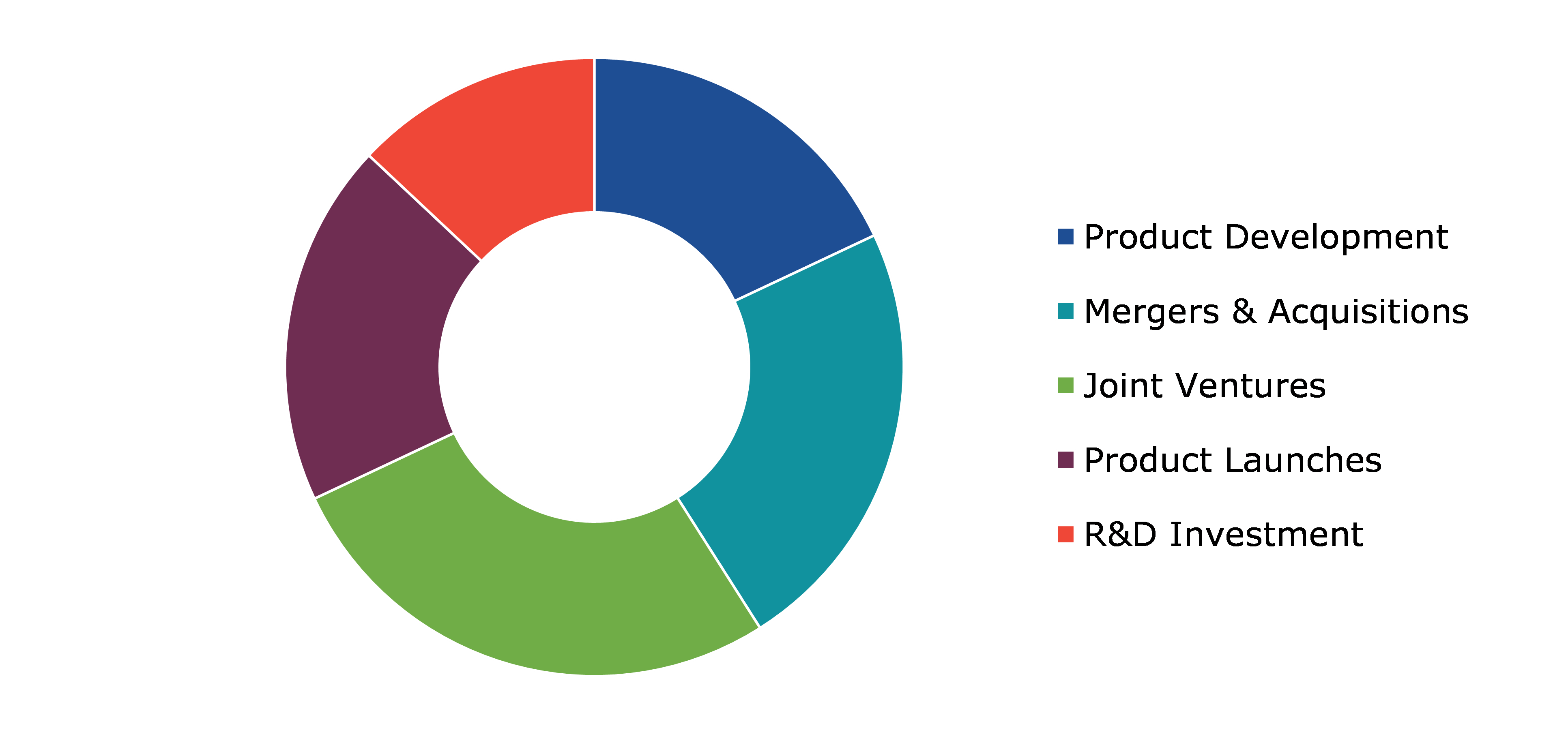Optical Glass Market Report
RA09212
Optical Glass Market by Raw Material (Boric Oxide, Zinc Oxide, Potassium Oxide, and Others), Type (Flint, Crown, and Others), Application (Consumer Optics, Industrial Equipment, Medical & Biotech, Semiconductors, and Others), and Region (North America, Europe, Asia-Pacific, and LAMEA): Global Opportunity Analysis and Industry Forecast, 2023-2032
Optical Glass Overview
The optical industry encompasses a wide range of applications that relate to the properties and movement of light. From lenses for eyeglasses and cameras to fiber optics, optical choices are a constant part of everyday life. Optical glass is an indispensable material used in many optical applications, inclusive of prisms, lasers, beam splitters, and other optical components. The two most common kinds of optical glass are flint glass and crown glass. Flint glass is produced using lead and crown glass includes a greater stage of potassium oxide.
Global Optical Glass Market Analysis
The global optical glass market size was $1,194.3 million in 2022 and is predicted to grow with a CAGR of 5.7%, by generating a revenue of $2,003.5 million by 2032.
Source: Research Dive Analysis
Growing Demand from the Consumer Electronics Industry to Drive the Market Growth
The consumer electronics industry is witnessing a surge in AR and VR devices, including headsets and smart glasses. These devices rely on sophisticated optical systems involving lenses, prisms, and waveguides, all of which require high-quality optical glass for optimal performance. As AR and VR technologies become more mainstream, the demand for optical glass in this segment is expected to grow significantly. Increasing adoption of optical glass (flint glass and crown glass) for customer electronics, such as smartphones, tablets, laptops, and TVs is estimated to drive market growth. According to the India Cellular & Electronics Association (ICEA), India had approximately 500 million smartphone users in 2019, and this range is developing steadily. Furthermore, wearable electronics, including smartwatches, fitness trackers, and AR glasses, require compact and lightweight optical components made from high-quality glass to deliver clear and accurate visual information to users. As wearable technology becomes more mainstream, the demand for optical glass in this sector is expected to increase. Many consumer electronics devices incorporate sensors for various purposes, such as proximity sensing, ambient light sensing, and gesture recognition. These sensors often rely on optical components like lenses and filters made from specialized glass materials to achieve accurate and reliable performance.
High Production Cost of Optical Glass to Restrain the Market Revenue Growth
Optical glass manufacturing often requires high-quality raw materials with specific chemical compositions and purity levels. These materials, such as silica, rare earth elements, and various metal oxides, can be expensive to source. Fluctuations in raw material prices can directly impact production costs, affecting the profitability of optical glass manufacturers. The production of optical glass involves energy-intensive processes such as melting, refining, and shaping. Furnaces used for glass melting require significant energy inputs, contributing to production costs. Energy prices and efficiency of manufacturing processes play crucial roles in determining overall production costs. Manufacturing optical glass often involves highly skilled labor, particularly in processes such as glass blowing, lens grinding, and quality control. Skilled labor tends to command higher wages, adding to production costs. In addition, stringent quality control measures are necessary to ensure that optical glass meets precise specifications, further increasing labor costs.
Rising Demand for High Resolution Imaging to Drive Excellent Opportunities
The emergence of high-resolution imaging gadgets such as DSLRs, mirrorless cameras, and high-end smartphones necessitates the use of exceptional optical glass for lenses, filters, and different optical components. As buyers demand sharper photographs with higher clarity and detail, producers are underneath pressure to use top class optical substances to meet these expectations. Professional photographers and videographers require optical equipment capable of capturing complex important points and nuances accurately. Therefore, there is a growing demand for top rate optical glass lenses and filters that can offer fantastic photograph quality, coloration accuracy, and contrast, especially in industries such as cinematography, flora and fauna photography, and aerial imaging. High-resolution imaging plays an indispensable position in clinical diagnostics, together with radiography, endoscopy, and microscopy. Optical glass components such as lenses, mirrors, and prisms are critical to scientific imaging devices, enabling healthcare professionals to visualize internal structures with brilliant clarity and precision. The increasing use of advanced imaging techniques in healthcare facilities worldwide provides significant opportunities for the optical glass market.
Global Optical Glass Market Share, by Raw Material, 2022
Source: Research Dive Analysis
The boric oxide sub-segment accounted for the highest market share in 2022. The use of boric oxide in the manufacture of optical glass allows for the production of glasses with specified optical qualities in terms of refractive index and light dispersion. Some optical glasses are made in continuous tank furnaces that are entirely lined with platinum to prevent any contamination. The glass melt is deposited into automatic press machinery, which produces lens blanks. The boric oxide content in optical glasses can range from zero to over 40% in the more recently developed rare earth borate glasses. The use of boric oxide allows producers to create new generations of optical glass with increased performance and extended potential. R&D efforts aimed at optimizing glass compositions and refining production processes drive innovation in the optical glass market, resulting in the introduction of new materials and solutions that meet evolving industry needs.
Global Optical Glass Market Share, by Type, 2022
Source: Research Dive Analysis
The flint sub-segment accounted for the highest market share in 2022. Flint glass is a mixture of silicon dioxide (SiO2) with lead or potassium. It produces a reasonably high refractive index and light dispersion capacity when compared to other varieties of glass. Flint glasses are arbitrarily defined as having an Abbe number of 50 to 55 or lower. Flint glasses feature refractive indices ranging from 1.45 to 2.0. Therefore, brightness, clarity, and luminosity properties of this glass blend make it stand out among other materials used in optical applications. This feature makes flint glass particularly useful for the manufacture of lenses, optical instruments, and prisms. Lead oxides are substituted in modern flint glass with other metal oxides such as titanium dioxide and zirconium dioxide, without appreciably changing the glass's optical characteristics.
Global Optical Glass Market Share, by Application, 2022
Source: Research Dive Analysis
The medical & biotech sub-segment accounted for the highest market share in 2022. In medical and biotech applications, optical glass refers to specialized glass materials used in various optical components such as lenses, mirrors, prisms, and filters for diagnostic and analytical instruments. These instruments are utilized in medical imaging systems, laboratory equipment, and biotechnology research tools to visualize and analyze biological samples with high precision and accuracy. Similarly, corrective optical glasses are essentially one of the most widely utilized medical equipment. Cameras and different imaging detectors are another major component of contemporary scientific devices that employ optical glasses for diagnostic systems each time viewing, collecting, or storing photographs.
Global Optical Glass Market Size & Forecast, by Region, 2022-2032 ($Million)
Source: Research Dive Analysis
The North America optical glass market generated the highest revenue in 2022. Several factors drive the North American optical glass market growth, including technical breakthroughs, increase in demand from various industries. Optical glass is used extensively in telecommunications, healthcare (medical imaging), aerospace, defense, automotive, and consumer electronics industries. The growing demand for high-quality imaging, accurate measurement, and advanced optical systems is driving the expansion of the optical glass market in North America. The region is home to several prominent consumer electronics manufacturers. The increasing adoption of smartphones, tablets, AR/VR devices, and other consumer electronics boosts the demand for optical glass components such as lenses, displays, and sensors.
Competitive Scenario in the Global Optical Glass Market
Investment and agreement are common strategies followed by major market players. For instance, in October 2022, Edmund Optics and SCHOTT have advanced their strategic partnership to provide customers in Asia with easy access to high-quality optical glass filters. In-region inventory greatly speeds up the delivery of standard filter types and sizes while in-region support simplifies the process for sourcing custom filters tailored for specific applications.
Source: Research Dive Analysis
Some of the companies operating in the optical glass market are Schott, Hoya, Ohara Corporation, Edmund Optics, Crystran Ltd., Sterling Precision Optics, Sumita Optical Glass, CDGM Glass Company, Nikon Corporation, and Carl Zeiss.
| Aspect | Particulars |
| Historical Market Estimations | 2020-2021 |
| Base Year for Market Estimation | 2022 |
| Forecast Timeline for Market Projection | 2023-2032 |
| Geographical Scope | North America, Europe, Asia-Pacific, and LAMEA |
| Segmentation by Raw Material |
|
| Segmentation by Type |
|
|
Segmentation by Application
|
|
| Key Companies Profiled |
|
Q1. What is the size of the global optical glass market?
A. The size of the global optical glass market was over $1,194.3 million in 2022 and is projected to reach $2,003.5 million by 2032.
Q2. Which are the major companies in the optical glass market?
A. Schott and Hoya are some of the key players in the global optical glass market.
Q3. Which region, among others, possesses greater investment opportunities in the near future?
A. Asia-Pacific possesses great investment opportunities for investors in the future.
Q4. What will be the growth rate of the Asia-Pacific optical glass market?
A. The Asia-Pacific optical glass market is anticipated to grow at 5.7% CAGR during the forecast period.
Q5. What are the strategies opted by the leading players in this market?
A. Agreement and investment are the two key strategies opted by the operating companies in this market.
Q6. Which companies are investing more on R&D practices?
A. Schott, Hoya, Ohara Corporation, Edmund Optics, and Crystran Ltd. are the companies investing more on R&D activities for developing new products and technologies.
1. Research Methodology
1.1. Desk Research
1.2. Real time insights and validation
1.3. Forecast model
1.4. Assumptions and forecast parameters
1.5. Market size estimation
1.5.1. Top-down approach
1.5.2. Bottom-up approach
2. Report Scope
2.1. Market definition
2.2. Key objectives of the study
2.3. Report overview
2.4. Market segmentation
2.5. Overview of the impact of COVID-19 on global Optical Glass Market
3. Executive Summary
4. Market Overview
4.1. Introduction
4.2. Growth impact forces
4.2.1. Drivers
4.2.2. Restraints
4.2.3. Opportunities
4.3. Market value chain analysis
4.3.1. List of raw material suppliers
4.3.2. List of manufacturers
4.3.3. List of distributors
4.4. Innovation & sustainability matrices
4.4.1. Technology matrix
4.4.2. Regulatory matrix
4.5. Porter’s five forces analysis
4.5.1. Bargaining power of suppliers
4.5.2. Bargaining power of consumers
4.5.3. Threat of substitutes
4.5.4. Threat of new entrants
4.5.5. Competitive rivalry intensity
4.6. PESTLE analysis
4.6.1. Political
4.6.2. Economical
4.6.3. Social
4.6.4. Technological
4.6.5. Legal
4.6.6. Environmental
4.7. Impact of COVID-19 on Optical Glass Market
4.7.1. Pre-covid market scenario
4.7.2. Post-covid market scenario
5. Optical Glass Market Analysis, by Raw Material
5.1. Overview
5.2. Boric Oxide
5.2.1. Definition, key trends, growth factors, and opportunities
5.2.2. Market size analysis, by region, 2022-2032
5.2.3. Market share analysis, by country, 2022-2032
5.3. Zinc Oxide
5.3.1. Definition, key trends, growth factors, and opportunities
5.3.2. Market size analysis, by region, 2022-2032
5.3.3. Market share analysis, by country, 2022-2032
5.4. Potassium Oxide
5.4.1. Definition, key trends, growth factors, and opportunities
5.4.2. Market size analysis, by region, 2022-2032
5.4.3. Market share analysis, by country, 2022-2032
5.5. Others
5.5.1. Definition, key trends, growth factors, and opportunities
5.5.2. Market size analysis, by region, 2022-2032
5.5.3. Market share analysis, by country, 2022-2032
5.6. Research Dive Exclusive Insights
5.6.1. Market attractiveness
5.6.2. Competition heatmap
6. Optical Glass Market Analysis, by Type
6.1. Overview
6.2. Flint
6.2.1. Definition, key trends, growth factors, and opportunities
6.2.2. Market size analysis, by region, 2022-2032
6.2.3. Market share analysis, by country, 2022-2032]
6.3. Crown
6.3.1. Definition, key trends, growth factors, and opportunities
6.3.2. Market size analysis, by region, 2022-2032
6.3.3. Market share analysis, by country, 2022-2032
6.4. Others
6.4.1. Definition, key trends, growth factors, and opportunities
6.4.2. Market size analysis, by region, 2022-2032
6.4.3. Market share analysis, by country, 2022-2032
6.5. Research Dive Exclusive Insights
6.5.1. Market attractiveness
6.5.2. Competition heatmap
7. Optical Glass Market Analysis, by Application
7.1. Overview
7.2. Consumer Optics
7.2.1. Definition, key trends, growth factors, and opportunities
7.2.2. Market size analysis, by region, 2022-2032
7.2.3. Market share analysis, by country, 2022-2032
7.3. Industrial Equipment
7.3.1. Definition, key trends, growth factors, and opportunities
7.3.2. Market size analysis, by region, 2022-2032
7.3.3. Market share analysis, by country, 2022-2032
7.4. Medical & Biotech
7.4.1. Definition, key trends, growth factors, and opportunities
7.4.2. Market size analysis, by region, 2022-2032
7.4.3. Market share analysis, by country, 2022-2032
7.5. Semiconductors
7.5.1. Definition, key trends, growth factors, and opportunities
7.5.2. Market size analysis, by region, 2022-2032
7.5.3. Market share analysis, by country, 2022-2032
7.6. Others
7.6.1. Definition, key trends, growth factors, and opportunities
7.6.2. Market size analysis, by region, 2022-2032
7.6.3. Market share analysis, by country, 2022-2032
7.7. Research Dive Exclusive Insights
7.7.1. Market attractiveness
7.7.2. Competition heatmap
8. Optical Glass Market, by Region
8.1. North America
8.1.1. U.S.
8.1.1.1. Market size analysis, by Raw Material, 2022-2032
8.1.1.2. Market size analysis, by Type, 2022-2032
8.1.1.3. Market size analysis, by Application, 2022-2032
8.1.2. Canada
8.1.2.1. Market size analysis, by Raw Material, 2022-2032
8.1.2.2. Market size analysis, by Type, 2022-2032
8.1.2.3. Market size analysis, by Application, 2022-2032
8.1.3. Mexico
8.1.3.1. Market size analysis, by Raw Material, 2022-2032
8.1.3.2. Market size analysis, by Type, 2022-2032
8.1.3.3. Market size analysis, by Application, 2022-2032
8.1.4. Research Dive Exclusive Insights
8.1.4.1. Market attractiveness
8.1.4.2. Competition heatmap
8.2. Europe
8.2.1. Germany
8.2.1.1. Market size analysis, by Raw Material, 2022-2032
8.2.1.2. Market size analysis, by Type, 2022-2032
8.2.1.3. Market size analysis, by Application, 2022-2032
8.2.2. UK
8.2.2.1. Market size analysis, by Raw Material, 2022-2032
8.2.2.2. Market size analysis, by Type, 2022-2032
8.2.2.3. Market size analysis, by Application, 2022-2032
8.2.3. France
8.2.3.1. Market size analysis, by Raw Material, 2022-2032
8.2.3.2. Market size analysis, by Type, 2022-2032
8.2.3.3. Market size analysis, by Application, 2022-2032
8.2.4. Spain
8.2.4.1. Market size analysis, by Raw Material, 2022-2032
8.2.4.2. Market size analysis, by Type, 2022-2032
8.2.4.3. Market size analysis, by Application, 2022-2032
8.2.5. Italy
8.2.5.1. Market size analysis, by Raw Material, 2022-2032
8.2.5.2. Market size analysis, by Type, 2022-2032
8.2.5.3. Market size analysis, by Application, 2022-2032
8.2.6. Rest of Europe
8.2.6.1. Market size analysis, by Raw Material, 2022-2032
8.2.6.2. Market size analysis, by Type, 2022-2032
8.2.6.3. Market size analysis, by Application, 2022-2032
8.2.7. Research Dive Exclusive Insights
8.2.7.1. Market attractiveness
8.2.7.2. Competition heatmap
8.3. Asia-Pacific
8.3.1. China
8.3.1.1. Market size analysis, by Raw Material, 2022-2032
8.3.1.2. Market size analysis, by Type, 2022-2032
8.3.1.3. Market size analysis, by Application, 2022-2032
8.3.2. Japan
8.3.2.1. Market size analysis, by Raw Material, 2022-2032
8.3.2.2. Market size analysis, by Type, 2022-2032
8.3.2.3. Market size analysis, by Application, 2022-2032
8.3.3. India
8.3.3.1. Market size analysis, by Raw Material, 2022-2032
8.3.3.2. Market size analysis, by Type, 2022-2032
8.3.3.3. Market size analysis, by Application, 2022-2032
8.3.4. Australia
8.3.4.1. Market size analysis, by Raw Material, 2022-2032
8.3.4.2. Market size analysis, by Type, 2022-2032
8.3.4.3. Market size analysis, by Application, 2022-2032
8.3.5. South Korea
8.3.5.1. Market size analysis, by Raw Material, 2022-2032
8.3.5.2. Market size analysis, by Type, 2022-2032
8.3.5.3. Market size analysis, by Application, 2022-2032
8.3.6. Rest of Asia-Pacific
8.3.6.1. Market size analysis, by Raw Material, 2022-2032
8.3.6.2. Market size analysis, by Type, 2022-2032
8.3.6.3. Market size analysis, by Application, 2022-2032
8.3.7. Research Dive Exclusive Insights
8.3.7.1. Market attractiveness
8.3.7.2. Competition heatmap
8.4. LAMEA
8.4.1. Brazil
8.4.1.1. Market size analysis, by Raw Material, 2022-2032
8.4.1.2. Market size analysis, by Type, 2022-2032
8.4.1.3. Market size analysis, by Application, 2022-2032
8.4.2. Saudi Arabia
8.4.2.1. Market size analysis, by Raw Material, 2022-2032
8.4.2.2. Market size analysis, by Type, 2022-2032
8.4.2.3. Market size analysis, by Application, 2022-2032
8.4.3. UAE
8.4.3.1. Market size analysis, by Raw Material, 2022-2032
8.4.3.2. Market size analysis, by Type, 2022-2032
8.4.3.3. Market size analysis, by Application, 2022-2032
8.4.4. South Africa
8.4.4.1. Market size analysis, by Raw Material, 2022-2032
8.4.4.2. Market size analysis, by Type, 2022-2032
8.4.4.3. Market size analysis, by Application, 2022-2032
8.4.5. Rest of LAMEA
8.4.5.1. Market size analysis, by Raw Material, 2022-2032
8.4.5.2. Market size analysis, by Type, 2022-2032
8.4.5.3. Market size analysis, by Application, 2022-2032
8.4.6. Research Dive Exclusive Insights
8.4.6.1. Market attractiveness
8.4.6.2. Competition heatmap
9. Competitive Landscape
9.1. Top winning strategies, 2022
9.1.1. By strategy
9.1.2. By year
9.2. Strategic overview
9.3. Market share analysis, 2022
10. Company Profiles
10.1. Schott
10.1.1. Overview
10.1.2. Business segments
10.1.3. Product portfolio
10.1.4. Financial performance
10.1.5. Recent developments
10.1.6. SWOT analysis
10.2. Hoya
10.2.1. Overview
10.2.2. Business segments
10.2.3. Product portfolio
10.2.4. Financial performance
10.2.5. Recent developments
10.2.6. SWOT analysis
10.3. Ohara Corporation
10.3.1. Overview
10.3.2. Business segments
10.3.3. Product portfolio
10.3.4. Financial performance
10.3.5. Recent developments
10.3.6. SWOT analysis
10.4. Edmund Optics
10.4.1. Overview
10.4.2. Business segments
10.4.3. Product portfolio
10.4.4. Financial performance
10.4.5. Recent developments
10.4.6. SWOT analysis
10.5. Crystran Ltd
10.5.1. Overview
10.5.2. Business segments
10.5.3. Product portfolio
10.5.4. Financial performance
10.5.5. Recent developments
10.5.6. SWOT analysis
10.6. Sterling Precision Optics
10.6.1. Overview
10.6.2. Business segments
10.6.3. Product portfolio
10.6.4. Financial performance
10.6.5. Recent developments
10.6.6. SWOT analysis
10.7. Sumita Optical Glass
10.7.1. Overview
10.7.2. Business segments
10.7.3. Product portfolio
10.7.4. Financial performance
10.7.5. Recent developments
10.7.6. SWOT analysis
10.8. CDGM Glass Company
10.8.1. Overview
10.8.2. Business segments
10.8.3. Product portfolio
10.8.4. Financial performance
10.8.5. Recent developments
10.8.6. SWOT analysis
10.9. Nikon Corporation
10.9.1. Overview
10.9.2. Business segments
10.9.3. Product portfolio
10.9.4. Financial performance
10.9.5. Recent developments
10.9.6. SWOT analysis
10.10. Carl Zeiss
10.10.1. Overview
10.10.2. Business segments
10.10.3. Product portfolio
10.10.4. Financial performance
10.10.5. Recent developments
10.10.6. SWOT analysis
Personalize this research
- Triangulate with your own data
- Request your format and definition
- Get a deeper dive on a specific application, geography, customer or competitor
- + 1-888-961-4454 Toll - Free
- support@researchdive.com







